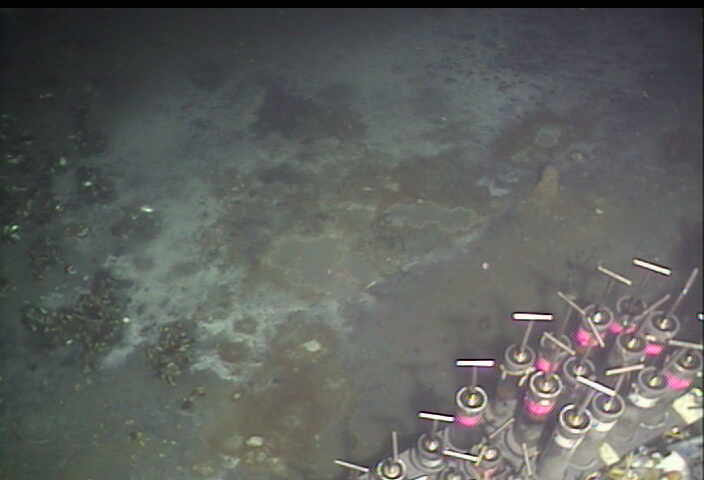Seafloor “cold seeps” are areas where cool fluids from the deep subsurface are leaking out of the seafloor. The temperature of these fluids is usually less than 20ºC. Most methane-fueled or methane and oil fueled cold seeps share some common features, such as gas vents or bubble streams, gas hydrate mounds, microbial mats, and chemosynthetic animals and associated heterotrophic fauna. The biological and chemical diversity of these habitats is high.
Barite chimney (white) at a mud volcano
On our current, we’ve been studying a different type of seep, places where super-salty brine, along with oil, gas, and fluidized mud, leak from the seafloor. When we started this cruise, we knew of two varieties of brine seeps in the Gulf of Mexico: mud volcanoes and brine pools/lakes. Mud volcanoes are characterized by high rates of fluid flow, higher temperature fluids (up to 40 ºC), and flow features like barite chimneys. Mud volcanoes do not usually have dense chemosynthetic communities associated with them because the fluidized mud impedes their development. Brine pools, lakes or basins are thought to have lower rates of fluid flux and these habitats often support development of dense chemosynthetic communities.
Bubbling mud pots along the shore of a brine pool
Our first ALVIN dive to GC246, a mud volcano site that had been imaged with JASON but never visited by a manned-deep ocean research submersible, revealed many surprises. This site had a little bit of everything, but some things just should not have been there. The seafloor around the site was dotted with mud pots and chimney structures. The brine flowing from the mud pots collected into a small brine pool. Upon close inspection, we realized the chimneys were not comprised of barite, rather they were sulfide chimneys. Sulfide chimneys at a brine seep? That’s pretty unusual.
Colorful sulfide chimney (about 7 cm wide and 15 cm tall)
This site was also unusual in that it was characterized by several different types of mineral crusts of varying color, red, white, orange (see image gallery below). At first, we thought these were microbial mats, but upon closer inspection, we realized they were primarily mineral. We did find lush microbial mats at this site, mainly white Beggiatoa, but most of the surface features were mineral crusts, which is strange.
Wispy Beggiatoa meadows along the edges of a mud volcano
A lot of work in the lab will be required before we can explain the features observed at this site but documenting the chemical composition of the lukewarm mud pot and brine pool fluids is where we’ll start.
Orange mineral crust
Crab at lakeshore
Strange landscapes
Seafloor fumarole









